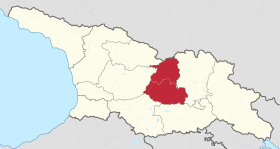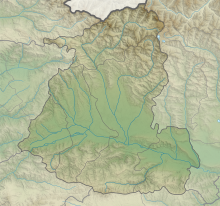Shida Kartli
Shida Kartli
შიდა ქართლი | |
|---|---|
 Shida Kartli region highlighted | |
| Country | |
| Seat | Gori[1] |
| Subdivisions | 5 municipalities |
| Government | |
| • Governor | Mamuka Saghareishvili[2] |
| Area | |
| • Total | 5,729 km2 (2,212 sq mi) |
| Population (2021[3]) | |
| • Total | 254,081[a]; (est. 284,081) |
| Time zone | UTC+4 (Georgian Time) |
| ISO 3166 code | GE-SK |
| HDI (2017) | 0.741[4] high · 7th |
| Website | shidakartli |
| ^a Without Russian occupied part of Shida Kartli. | |
Shida Kartli (Georgian: შიდა ქართლი, šida kartli, [ʃidɑ kʰɑrtʰli]; "Inner Kartli") is a landlocked administrative region (Mkhare) in eastern Georgia. Comprises a central part of the historical-geographic province of Shida Kartli. With an area of 5,729 square kilometres (2,212 sq mi), Shida Kartli is the 8th largest Georgian region by land area. With 284,081 inhabitants, it is Georgia's seventh-most-populous region. Shida Kartli's capital and largest city, Gori, is the 5th largest city in Georgia.[3]
The region is bordered by the Russian Federation to the North, Georgian regions of Mtskheta-Mtianeti to the East, Kvemo Kartli to the South, Samtskhe-Javakheti to the Southwest, Imereti to the West, and Racha-Lechkhumi and Kvemo Svaneti to the Northwest. It consists of the following municipalities: Gori, Kaspi, Kareli, Java, Khashuri.
The northern part of the region, namely Java, and northern territories of Kareli and Gori municipalities (total area of 1,393 km²), have been controlled by the authorities of the self-proclaimed Republic of South Ossetia since 1992 and occupied by Russian troops since 2008 Russo-Georgian war.
Etymology[]
The name Shida Kartli in English translates as Inner Kartli. The term Kartli itself derives from Proto-Kartvelian root *kart- ("Georgian"), which is considered an ancient inner-Kartvelian formation by modern linguists.[5][6]
Geography[]

Shida Kartli is located in a central part of the lowland between Greater and Lesser Caucasus. To the North, Shida Kartli shares 27.5 km international border with Russian Federation. As of 2018, the Georgian government lacks control over it, hence the border is closed for international transit. To the East, the region shares an administrative border with Mtskheta-Mtianeti, to the South with – Kvemo Kartli, to the Southwest – with Samtskhe-Javakheti, to the West – with Imereti, and to the Northwest – with Racha-Lechkhumi and Kvemo Svaneti.[7]
The region's northern border is formed by the Greater Caucasus mountains, the eastern border mainly goes along the Kharuli ridge and the Ksani River, the southern border goes along the Trialeti Range, and the western border is formed by the Likhi and Racha ranges.
Relief[]

Overall picture of Shida Kartli's relief is formed by extensive Shida Kartli plain and mountainous edges. The main orographic entities of the region are: small parts of the Greater Caucasus mountains and Racha range, Germukhi, Kharuli, Kvernaki, Trialeti, Likhi ranges and .[8]
The average height of the Shida Kartli terrain is 1,307 meter. The lowest point is at 473 meter in Kaspi municipality, at the confluence of the Mtkvari and the Ksani rivers. The highest point is the mountain Laghztsiti (3,877.4 m) which is located in occupied part of Shida Kartli. On the Georgian controlled part of the region the highest point is the mountain Arjevani (2,757.7 m).[9]

Climate[]
Shida Kartli has various climate, in its central part, on the plain is represented moderate humid climate, with moderate cold Winters and warm long Summers. To the East from Gori environs, along Mtkvari valley (up to 600 m), is represented transient climate from dry subtropics to moderate humid subtropics, with moderate cold Winters and hot Summers. To the North of the plain on southern slopes of the Greater Caucasus mountains (1,100-1,900 m) and to the South on northern slopes of the Trialeti range (1,400-1,900 m) climate is moderate humid with cold Winters and long Summers and from 1,900 m to 2,600 m with cold Winters and short Summers. On southern slopes of the Greater Caucasus mountains from 2,600 m to 3,400 m is represented moderate humid climate of the highlands with lack of true Summer, and above 3,400 m – moderate humid climate of the highlands with permanent snow and glaciers. To the west of the region, on Likhi range above 900 m is distributed transient highlands climate from marine humid to continental humid. To the most North-western part of the region, on western slopes of Likhi range and Racha range is represented humid climate with cold Winters and short Summers, and above 2,600 m – humid highlands climate with lack of true Summer.[10]
Temperature[]

An average annual temperature of the region is 6.5 °C, maximum annual temperature of 12.2 °C is to the East of the Kaspi Municipality and minimum annual temperature of -5.0 °C is in the Java Municipality, on the Caucasus Mountains. The highest average annual temperature is on the Shida Kartli plain which rises from the West to the East direction from 9 °C to 12.2 °C.[11] The hottest month of the region is August (18.5 °C) and its maximum average monthly temperature reaches 24.4 °C, while minimum – drops to 4.5 °C. The coldest month is January (-2,6 °C) and its minimum average monthly temperature drops to -12.6 °C, while maximum reaches – 1.6 °C.[12]
Precipitation[]
On the territory of Shida Kartli an average annual precipitation equals to 824 mm. Maximum of a precipitation (1,045 mm) falls to the very North of the region, on the Caucasus Mountains, while minimum (536 mm) – falls to the East of Kaspi Municipality, along Mtkvari valley. By abundance of precipitation, stands out northern part of the region where its amount varies from 800 mm up to 1,045 mm. On the Shida Kartli plain an average annual precipitation varies from 563 mm up to 800 mm, and on the Trialeti Range – from 700 mm up to 900 mm.[11]
By month, maximum average annual precipitation falls in May (109 mm) and June (105 mm), while minimum – in February (57 mm).[12]
Winds[]
In Shida Kartli the strongest winds blow in December and January, on average their speed reach 2.49 m/s and 2.35 m/s respectively. The weakest winds are in October (1.83 m/s). In the region winds usually blow from the East or the West side. By territorial distribution winds are especially strong on the southern slopes of the Greater Caucasus Mountains, while the weakest – on the Shida Kartli plain.[12]
See also[]
- Subdivisions of Georgia
- Kartli
- Samachablo
- 2008 Russo-Georgian war
- Occupied territories of Georgia
References[]
- ^ "City Gori". shidakartli.gov.ge. Government of Georgia. Retrieved 8 March 2018.
- ^ "Governor". shidakartli.gov.ge. Government of Georgia. Retrieved 8 March 2018.
- ^ a b "Statistics of Shida Kartli Region". www.geostat.ge. The National Statistics Office of Georgia. Retrieved 5 August 2021.
- ^ "Sub-national HDI - Area Database - Global Data Lab". hdi.globaldatalab.org. Retrieved 2018-09-13.
- ^ Klimov, Georgy (1998). Etymological Dictionary of the Kartvelian Languages. Berlin: Walter de Gruyter. p. 213. ISBN 9783110156584. Retrieved 7 June 2015.
- ^ Fähnrich, Heinz (2007). Kartwelisches Etymologisches Wörterbuch. BRILL. p. 458. ISBN 9789004161092. Retrieved 7 June 2015.
- ^ "შიდა ქართლის რეგიონის განვითარების სტრატეგია. 2014-2021" (PDF). gov.ge. Government of Georgia. Retrieved 8 March 2018. (in Georgian)
- ^ Sokhadze, Marine (2008). საქართელოს ატლასი [Atlas of Georgia] (in Georgian). Tbilisi: Bakur Sulakauri Publishing.
- ^ "ASTER Global Digital Elevation Map". asterweb.jpl.nasa.gov. NASA. Retrieved 8 March 2018.
- ^ Kordzakhia, Mitropane (1961). საქართველოს ჰავა [Climate of Georgia] (in Georgian). Tbilisi: Georgian SSR Science Academy.
- ^ a b Hijmans, R.J.; Cameron, S.E.; Parra, J.L.; Jones, P.G.; Jarvis, A. (2005). "Very high resolution interpolated climate surfaces for global land areas". International Journal of Climatology. 25 (15): 1965–1978. doi:10.1002/joc.1276.
- ^ a b c Fick, S.E.; Hijmans, R.J. (2017). "Worldclim 2: New 1-km spatial resolution climate surfaces for global land areas". International Journal of Climatology. 37 (12): 4302–4315. doi:10.1002/joc.5086.
External links[]
- Shida Kartli
- Regions of Georgia (country)

